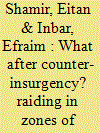| Srl | Item |
| 1 |
ID:
116323


|
|
|
|
|
| Publication |
2012.
|
| Summary/Abstract |
This article examines models for the organisation of defence at the highest level and considers their suitability to operate in the contemporary strategic environment. We characterise the contemporary environment and test against this characterisation a 'separated' model for strategic-level defence organisation, which contains distinct political strategic and military strategic structures and functions, and an 'integrated' model in which these structures and functions have been brought together. From this analysis, and by drawing on the experiences of the commercial sector, we conclude that in matching the environment, an integrated model offers considerably more and clearer advantages than a separated one.
|
|
|
|
|
|
|
|
|
|
|
|
|
|
|
|
| 2 |
ID:
148835


|
|
|
|
|
| Summary/Abstract |
The decade following the international intervention in Afghanistan in 2001 facilitated Indian presence in Afghanistan in the form of “effective” aid and assistance which resulted in remarkable goodwill and high appreciation for India and Indian democracy. India’s engagement was also gradually accepted by the international community for the role that she could play in Afghan reconstruction and as a provider of regional stability.
|
|
|
|
|
|
|
|
|
|
|
|
|
|
|
|
| 3 |
ID:
148470


|
|
|
|
|
| Summary/Abstract |
This article argues that the option of a military raid is becoming more relevant in the contemporary strategic environment. Two developments lead to this conclusion: the increase in the number of so-called failed states and subsequently ungoverned areas; and the western inadequate response in the attempts to create zones of stability with clear strategic addresses. The efforts for statebuilding in Iraq and Afghanistan have failed, and the US and its allies have realized that foreign interventions, even after the commitment of much treasure and blood, are ineffective. This means that the West must adapt its strategic thinking to the new developments and devise ways to deal effectively with the situation. This article explores the concept of strategic raid and elaborates on its theoretical underpinnings. The raids discussed here are military operations conducted in order to weaken and/or deter a non-state actor, at least temporarily. In the absence of diplomatic and economic leverage, the aim is limiting the actor's ability to harm others. The use of force is designed to degrade the military capabilities of the non-state adversary and to influence its resolve. Subsequently, it discusses a few historical examples of raiding strategy and then analyses two contemporary cases, Israel and the United States, in order to demonstrate the utility of raids today. Finally, the relevance of raiding strategy for other states in the contemporary strategic environment is discussed.
|
|
|
|
|
|
|
|
|
|
|
|
|
|
|
|